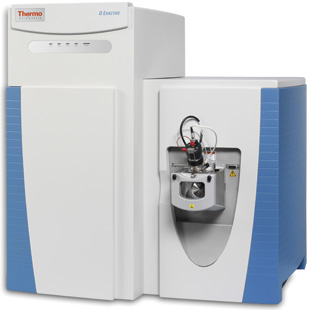Proteomics, the analysis of proteins present in a cell under different conditions, has always lagged behind genomics, as a rush of technological innovations made comprehensive genome mapping dizzyingly quick and achievable even for laboratories without access to core facilities. But unlike the main goal of genomics—laying out a primarily static sequence of base pairs—proteomics, with its diversity of shape, size, and sequence, presents more problems to tackle.
“Some scientists have proposed that the complexity of the proteome is unbounded,” explains Bradford Gibson of the Buck Institute for Research on Aging in Novato, California, citing splice variation, phosphorylation, time-dependent changes in protein expression, turnover, and interactions as examples of what makes proteomics complicated. But for all its infinite variability, proteomics is on the cusp of a sea change in technology that will help scientists get a better grip on what’s going on in the cells they study.
Mass spectrometry, long...
All protein mass spectrometry works by the same basic principle: proteins or peptides are ionized in some fashion, then fragmented, and the mass-to-charge ratio is measured, yielding characteristic spectra. A comprehensive proteome map requires that the mass spectrometer be sensitive, detecting both rare and abundant peptides; that it have high resolution to help discriminate a complex cocktail of protein species; and ideally, that the instrument be fast, so analyzing a single proteome doesn’t take all year. Time-of-flight (TOF) instruments, which have existed in basic form since the late 1940s, shoot ionized peptides through an electromagnetic field in a vacuum tube and rely on the fact that ions of different masses traverse the tube at different speeds. This method resolves peptides well, but has a tendency to miss rare peptides. Quadrupole-ion-trap analyzers separate ions based on their stability as they pass through an oscillating current moving between four conducting rods; these instruments are sensitive, but not ideal for differentiating peptides of similar mass.
It’s only recently that engineers have been able to combine the advantages of different mass-spec instruments into the same machine. A new type of mass-spec analyzer manufactured by Thermo Scientific, called the Orbitrap, which oscillates ions and uses complex mathematics to get high accuracy, resolution, and range, only appeared on the scene in 2005, but the machine’s speed and range have increased dramatically since then. And a new strategy for collecting data enables the newest of the venerable TOF instruments to survey an entire proteome, helping to speed and deepen proteomic analysis.
A Spike in Spectra
Matthias Mann’s group at the Max Planck Institute for Biochemistry in Martinsried, Germany, used recent innovations to the Orbitrap to produce some of the most complete yeast and human proteome maps to date.

In 2008, when Mann and his colleagues attempted the most complete mass spectrometry-based yeast proteome identification and quantification ever, they relied on the novel features of Thermo Scientific’s LTQ-Orbitrap, which had only been on the market for about 3 years but had significant advantages over its predecessors in detecting and distinguishing peptides.
In contrast to most other mass analyzers, ions enter an Orbitrap’s electromagnetic field at an angle, which traps them and forces the ions to oscillate around a central electromagnet. The oscillating ions generate currents as they pass detector electrodes, and a complex mathematical conversion called a Fourier transform translates the currents into mass spectra. The early Orbitrap machines were able to combine high resolution, wide dynamic range, and mass accuracy. Mann’s group relied on their fine resolution because their experiments depended on a subtle shift in spectra. They used a procedure Mann developed 10 years ago, called SILAC (stable isotope labeling by amino acids in cell culture), to label yeast metabolic proteins. By mixing labeled and unlabeled samples together, they could see the subtle shift produced by heavier isotope-labeled amino acids in certain peptides, which allowed the researchers to use ratios of heavy and light to both identify and quantify proteins in the same experiment. They were even able to compare protein levels in diploid versus haploid yeast, which gave insight into pathways that differed in these two life stages.
In 2010, the group decided to tackle the human proteome, which contains about two to three times as many proteins as the yeast proteome. They employed Thermo Scientific’s LTQ Orbitrap Velos, which applied a series of voltages to focus the ion beam entering the instrument, improving the efficiency of ion transfer into the instrument by 10-fold. Using HeLa cells, a human cell line, they identified more than 10,000 proteins, which they matched to just over 9,000 genes.
Thermo Scientific’s newest Orbitrap, the Q-Exactive, adds a quadrupole mass filter, which was not available on the LTQ Orbitrap in 2008. The quadrupole helps rapidly separate peptide ions of different masses for fragmentation, allowing the ions to be broken apart almost as quickly as they’re selected in the filter, which increases speed. The Q-Exactive also increases speed by fragmenting and analyzing in parallel rather than sequentially, allowing the instrument to analyze one set of ions while the next is being fragmented. A comparable resolution can be reached in half the time of the Velos. Coupling the Q-Exactive to the latest high-pressure liquid chromatography allowed Mann’s group to produce a complete yeast proteome in a single experiment, eliminating the need to separate the peptides prior to mass-spec analysis. The researchers were able to compare yeast grown under different conditions, and quantify changes in heat shock proteins and stress-related pathways.
In 2008, using the LTQ-Orbitrap, says Mann, it took 3 months to generate the yeast proteome map, which included almost 4,000 proteins. Now, the Q-Exactive’s advances enable the same procedure to be done in about 4 hours.
Another of the Orbitrap’s assets is its small size, adds Mann. “It’s not tiny, but it still fits on a bench top,” he says, and also notes its relative ease of use, which puts complex proteomics experiments within reach of mass spectrometry neophytes. A mass spectrometry expert himself (Mann helped develop the electrospray ionization technology that, equally with matrix-assisted laser desorption/ionization [MALDI], is one of the standard ionization strategies in mass spectrometry), Mann collaborates with many biologists who aren’t specialists. He doesn’t see any big changes on the Orbitrap’s horizon: “The hardware’s very good. There are no big conceptual problems,” he explains, forecasting that “in the next 2 years it will become more robust and cheap.”
Cutting a New SWATH
Another strategy takes the latest in mass spectrometry instrumentation, uses it differently, and captures the data differently. SWATH technology, so called after the “swaths” of mass ranges used to scan peptide ions, has been developed by Ruedi Aebersold at the Institute of Molecular Systems Biology in Zurich, Switzerland, with mass spectrometer manufacturer AB SCIEX. The concept was first published online in January 2012, in Molecular & Cellular Proteomics.

The idea, says Gibson of the Buck Institute for Research on Aging, is to collect information on as many peptides as possible during one mass spectrometry run, creating a library of mass spectra that can later be mined for proteins, without the need to perform the experiment anew. SWATH technology “came from the understanding that there’s a lot of under-sampling in data-dependent experiments,” such as shotgun proteomics, says Gibson, who has been implementing the new methodology in his lab. Mass spectrometers don’t, and can’t, record data on all ions produced; instead, high peptide concentrations trigger data acquisition, but this means that more data is collected on proteins that are abundant. Proteins that are rare in the sample, or don’t fractionate or ionize well, will often be missed. But this bias also opens the possibility for scientists to use relative sampling to ascertain protein abundance, both identifying and quantifying peptides in the same experiment. The strategy relies on the idea that the frequency at which a peptide is detected correlates well to its relative abundance in the samples.
“It’s not a new idea,” says Gibson, who notes that John Yates at Scripps Research Institute proposed a similar strategy in 2004, but at the time, the mass spectrometry technology on the market couldn’t support the strategy well enough.
Gibson’s lab, which uses mass spectrometry to investigate the utility of phosphoproteins as cancer biomarkers, among other projects, recently upgraded to AB SCIEX’s TripleTOF 5600, the machine Aebersold’s group used to develop SWATH. Already, says Gibson, his lab members are noticing a positive impact on their experiments. Ten years ago, scanning the peptides in a sample would have taken 2 seconds; current technology can do 30 scans in 1 second.
SWATH technology comes into play during a second pass through the mass analyzer, after peptide ions have fractionated a second time via collision. The spectrometer is set to analyze the ions in clearly defined spectral ranges called swaths, says Ron Bonner a principle scientist at AB SCIEX. The quadrupoles’ quick switching between swaths allows the instrument to cycle through 32 swaths and gather information on all detectable ions.
Using this protocol to examine how comprehensively SWATH methodology could map a proteome, Aebersold’s group identified almost 4,000 yeast proteins, essentially corresponding to the complete yeast proteome, confirming the method’s utility. One of the best features of this new setup is speed, says Bonner. Only a few years ago, a shotgun approach aimed at mapping a proteome could take a month, because it required prefractionating the proteins and running each fraction as many as 8 times to avoid missing peptides. SWATH requires no prefractionation before the samples are applied to liquid chromatography columns, and Aebersold has mapped about 2,000 yeast proteins in a 2-hour run, says Bonner.
Combining quantification and identification in one experiment has changed how Gibson’s lab approaches experiments such as biomarker discovery projects. Before, he says, it could be a laborious, months-long process to first begin identifying possible proteins of interest, and then perform the necessary experiments to quantify their abundance. Now lab members are planning experiments that identify and quantify in one run. Researchers in Gibson’s lab are pleased with the 5600’s sturdiness as well, he says. Previous instruments sometimes needed frequent servicing or required a month’s worth of troubleshooting to identify why detection sensitivity had dropped off, but the new instrument’s detectors have remained stable for months, which also helps when scientists want to compare experiments done half a year apart.
“It’s changed the game of how we do experiments in the lab,” Gibson says. “Now when we sit down to design, we build SWATH acquisition into almost everything. It works.”
Interested in reading more?




